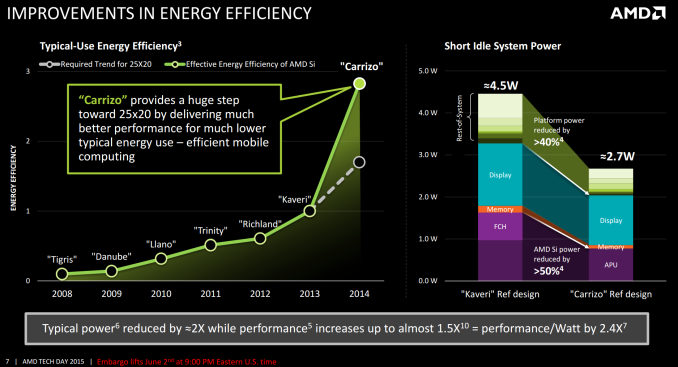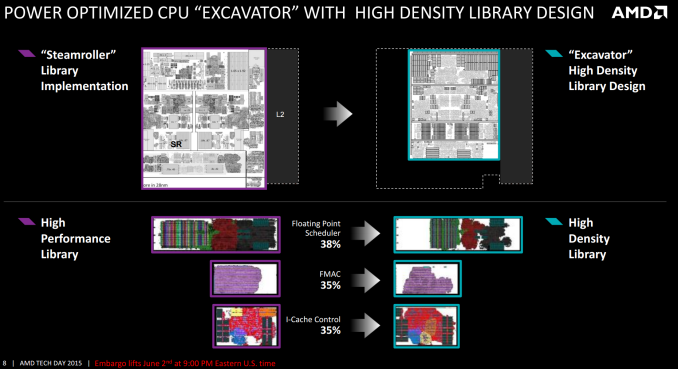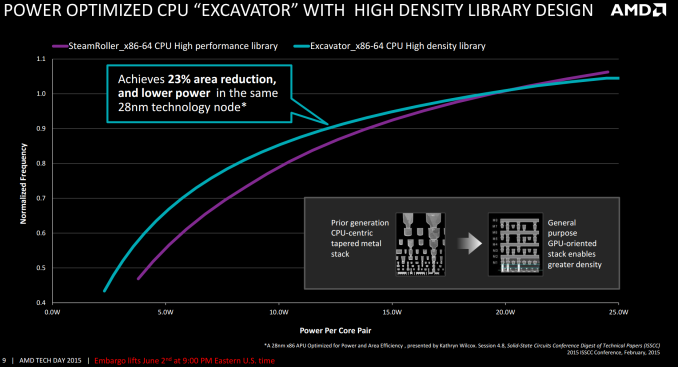AMD Launches Carrizo: The Laptop Leap of Efficiency and Architecture Updates
by Ian Cutress on June 2, 2015 9:00 PM ESTEfficiency and Die Area Savings
AMD’s take home message in all of this is efficiency. We a being quoted a performance per watt increase of 2.4x, coming from typical power draw savings of 2x and performance increase of almost 1.5x for 23% less die area, all in one go.
Ultimately this all helps AMD’s plan to be 25x more efficient with their APUs by 2020, and the cumulative bar chart on the right is how mobile improvements from all sides are being realized. Migrating the southbridge on die severely reduces its idle power consumption to almost zero and can help efficiencies elsewhere in the system. The APU general use and memory controllers are the next targets, but the common constant here is the display. Using a low power display might give battery life in exchange for quality, and there is only so much power you can save at the SoC level. In time, the display will be the main focus of power saving for these devices.
A big part of the reduction in die area comes from the set of high density libraries being used by AMD. Above were three examples provided where >33% gains were made in silicon area. Typically using a high density library design is a double edged sword – it reduces die area and potentially leaves more area for other things, but the caveat is that it may be more prone to defects in construction, require additional latency or have a different frequency/voltage profile. AMD assures us that these changes are at least like-for-like but most of them contain other improvements as well.
It’s worth noting here that AMD has described the high density library project internally as the equivalent of a moonshot, essentially the developers were part of a ‘skunkworks’ division attempting to make drastic changes in order to improve performance. The high density library is one such successful project from that.
With the new libraries, comparing Excavator to Steamroller shows the effect moving designs has. The power/frequency curve below 20W per module shifts to higher frequency/lower power, whereas losses are observed above 20W. However for 15W per module, this means either a 10%+ power reduction at the same frequency or a 5% increase in frequency for the same power. Should AMD release dual thread / single core APUs in the 7.5W region, this is where most of the gains are (as noted in the comments, the dual module designs are at 7.5W per module, meaning that what we should see in devices is already in the peak value for gains and benefits such as 25% frequency or 33% power). As also seen in the insert, the silicon stack has been adjusted to a more general purpose orientation. I could comment that this makes the CPU and GPU work better together, but I have no way of verifying this. AMD states the change in the silicon stack makes production slightly easier but also helps with achieving the higher density Excavator exhibits.













137 Comments
View All Comments
Cloakstar - Wednesday, June 3, 2015 - link
These scores definitely need validation. If true, Carrizo is a massive win.The FX 8800P graphic shows a 3DMark 11 score of nearly 2000 at 15W, and 2700+ at 35W.
The A10-7850k has a score of 2403 at 95W.
http://www.anandtech.com/show/7677/amd-kaveri-revi...
azazel1024 - Wednesday, June 3, 2015 - link
I didn't realize AMD's processors were so terrible at video playback. My 2 year old (pushing 3 now) Ivy Bridge i5-3317u equipped HP Envy 4t can manage roughly 6hrs of video playback of a 1080p h.264 12Mbps source and it only has about a 45whr battery in it. With a higher TDP chip and lots of "not power saving" features.creed3020 - Wednesday, June 3, 2015 - link
I am definitely in the market for one of these laptops to replace two older laptops in the house with one new one. If it had Carrizo for the hear I would be mighty happy to support AMD over Intel for this round, as the improvements here sound very much adequate for the system I am looking for.The ideal system would be something like the HP Spectre x360 for around $750.
michal1980 - Wednesday, June 3, 2015 - link
AMDs problem start with the 1st slide. "more people by notebooks priced between $400 and 700 than at any other price. Almost 2 out of every 5 notbooks sold is in that segment."umm, 3 out of 5 notebooks is sold outside of the 400-700 dollar price. Thats greater then 2 out of 5.
AMD fails math. Fails in general.
silverblue - Wednesday, June 3, 2015 - link
No. 3 out of 5 notebooks are either sold below $400, or above $700, and out of those two disparate segments, neither is as large as the $400 - $700 segment.There isn't a "math" fail here.
takeship - Wednesday, June 3, 2015 - link
The bigger issue is that AMD is admitting they are so uncompetitive in the market that it doesn't make business sense to chase at least 60% of consumers (and ignoring business costumers completely). And realistically, that 400-700 market is really more like a 550-700 market, as 400-500 is close enough to base iPad Air 2/premium Android tab pricing that you lose a lot of sales that direction.silverblue - Wednesday, June 3, 2015 - link
Surely TrustZone is a sign that they want business customers? Additionally, being able to work on the battery all day is a good thing.Gigaplex - Thursday, June 4, 2015 - link
Read closer. Their "all day battery" claim is being able to idle for 8 hours. You won't get a full work day out of that.silverblue - Friday, June 5, 2015 - link
If you class H264 1080p video as idle, sure. My fault for saying "work" though, however if all you're doing is light stuff, you won't be far off.FlushedBubblyJock - Wednesday, June 10, 2015 - link
for amd's sake we'll class idle as full screen video playback and 1.5 hours as all day, and no wifi bluetooth or dvd player active as full multimedia active -there, now look, you were correct ! your ego is in tact, you're never wrong
Calgon take me away